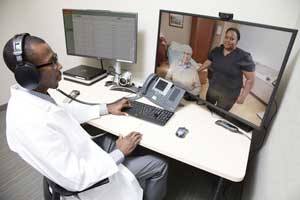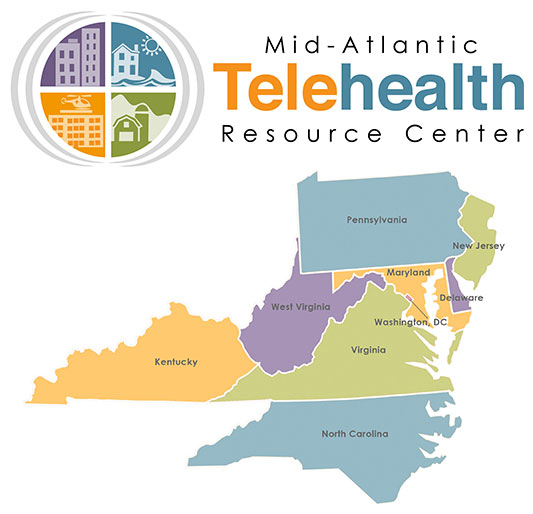Aug 31, 2022
Telehealth Brings Important Services to Rural Long-Term Care Facilities
by Allee Mead

Laurie Archbald-Pannone, MD, is a geriatrician and an associate professor of medicine at the University of Virginia who has worked in long-term care facilities and has a background in infectious diseases. Even before the COVID-19 pandemic, she helped provide education about infection control in long-term care facilities.
In early 2020, Archbald-Pannone and others reached out to long-term care facilities to hear their concerns about COVID-19. "We've seen the devastation COVID could cause in long-term care facilities from the West Coast and wanted to do whatever it is we could to be proactive and try to prevent outbreaks," she said.

Archbald-Pannone's team held almost daily Project ECHO sessions with about 13 facilities in the region to see how UVA could address their most pressing needs and to allow facilities with more telehealth experience share information with facilities just starting up programs. Topics included personal protective equipment, setting up isolation wards, and vaccination distribution.
Archbald-Pannone said the sessions improved how information was distributed: "It wasn't just the people who already knew somebody that they could ask a question to, but to really provide experts, to have these discussions…To be able to bring that type of quick and easy access to our more remote or more rural facilities improved the spread of knowledge."
The COVID-19 pandemic wreaked havoc on long-term care facilities as well as highlighted the importance and potential of telehealth services as one way to keep patients out of overcrowded hospitals. Over two years from the start of the pandemic, telehealth is here to stay but many rural nursing homes may still struggle to incorporate it into everyday services. A 2021 article titled An Evaluation of Telehealth Expansion in U.S. Nursing Homes reported that nursing homes in rural areas had lower use of telehealth than urban nursing homes. For example, rural nursing homes were less likely than urban to receive electronic reports of lab results or have remote order entry for medications from external providers.
Yet rural nursing homes and other long-term care facilities can benefit from telehealth. For example, since rural nursing homes do not have a physician onsite 24/7, these facilities can use telehealth to consult with an offsite healthcare professional and potentially prevent a patient from being transferred to a hospital. Staying onsite can lower costs and put less physical and emotional strain on a patient.
Mental Health Services in a Skilled Nursing Facility
Lisa Bean is a minimum data set (MDS) nurse and the Clinical Reimbursement Coordinator at Alpine Healthcare Center in Keene, New Hampshire. Alpine is a skilled nursing facility (SNF) with both short-term rehabilitation and long-term care as well as a memory unit. The SNF, with an 83-patient capacity, has a medical director and nurse practitioner as well as physical and occupational therapists. Alpine patients range from 50 to 90 years old and have presented with a variety of different physical health conditions as well as mental health diagnoses like schizophrenia. Alpine also has some hospice patients and is a VA provider.
Bean said mental healthcare is an important part of their work since the residents are often here due to a traumatic event or life-changing diagnosis and need someone to talk to: "Mental health services are a big hole that needs to be filled right now. And it impacts the elderly person who isn't managing at home anymore because of their vision and their cognition and maybe their diabetes and their heart disease. But it's also the people that were homeless and couldn't return to the shelters because of their medical issues."
Alpine connects residents with a psychologist who provides services via telehealth once a week. There is a small group of residents that the psychologist meets with regularly. In addition, Alpine's social worker can request that other residents meet with the psychologist. The social worker can also talk with the psychologist and provide more context if needed in regard to residents' situations.
Bean remembers a situation where a resident had been experiencing suicidal ideation. The psychologist had met with him more than once and had determined that the resident had not made any plans or attempts on his life. Then, when this resident's behavior changed, the psychologist was able to alert staff and recommended that the resident get a psych evaluation outside the SNF. "The fact that she was able to identify a change in his presentation and advocate for him to be seen someplace else was a good thing," Bean said.
On the physical health side of things, Alpine has occasionally set up a consultation with a specialist via telehealth, if a patient wasn't able to travel to another healthcare facility. When the facility did not have a physical therapist onsite, it has completed a few physical therapy evaluations over telehealth.
Benefits of Telehealth in Long-Term Care Facilities

Kathy Hsu Wibberly, PhD, Director of the Mid-Atlantic Telehealth Resource Center (MATRC), said that, for long-term care residents with dementia and other memory disorders, traveling to another facility for care is stressful. Being in an unfamiliar environment takes a toll on these residents, and they often need a few days after travel to adjust. Telehealth allows them to stay "in an environment where they feel comfortable, where they feel safe, and where they have familiarity," Wibberly said. MATRC serves eight states and Washington, D.C.
Seeing residents in their facilities has benefits for the providers as well. As a geriatrician, Archbald-Pannone said that patients getting to stay in their facilities allows her to see them in an environment where they're more comfortable than they might be in a doctor's office. "Here we are in their comfort zone, surrounded by people that they know, and that can often become a much more fruitful discussion as well," she said.
Here we are in their comfort zone, surrounded by people that they know, and that can often become a much more fruitful discussion as well.
In addition, Archbald-Pannone said that telehealth is often a crucial service for long-term care residents who are chronically ill or have limited mobility, since having to travel to another facility for a follow-up appointment is a challenge.
Telehealth "gives us the opportunity to still have that conversation face to face, in detail and in depth, without the patient having to come all the way out, an hour or two hours," Archbald-Pannone said. "For a 20-minute conversation that would happen in the office, we can translate that into a 20-minute conversation that can happen in the activities room of the facility." Telehealth can save time for the residents as well as for the employees who would otherwise need to transport residents to another facility.

Josh Hofmeyer, Vice President and General Manager for Senior Care Services at Avel eCare, a large telemedicine provider across the country, said that rural long-term care residents benefit from telehealth because it grants them "quicker access" to providers. "Even if they have a local clinician, sometimes it can take a while to hear back from them," he said. "Not because that clinician doesn't want to get back to them, but a lot of times in those rural communities, that clinician is wearing multiple hats. They're covering the clinic, they're covering the emergency department, they're covering the nursing home." In addition, he stated that telehealth services in the long-term care setting reduce transfers to the emergency department and urgent care, which lowers healthcare costs and hospitalization and rehospitalization rates.
Challenges and Lessons Learned
While telehealth can prevent patients with dementia from getting disoriented from traveling, it's not a perfect fit for all dementia patients. Bean from New Hampshire said that some Alpine residents with dementia "can't figure out they're talking to a machine." With these residents, Bean would prefer a situation where the healthcare professional is either staffed onsite or visits regularly and can develop a relationship with a resident in person, in an environment where they're more comfortable.
Bean added that the biggest barriers to telehealth in her facility are space and privacy. Residents live in two-person or four-person rooms, so they don't have any privacy in their rooms to talk to a psychologist. (In cases where a specialist wants to complete a bedside consultation with a resident, their roommate is moved to another space in the facility.) "We have been using a room that's considered a nursing training room and social services is set up right there in that room. We have to make sure that room is available, and then we have to get our residents down there. Many of them can't get there themselves," Bean said.
A major barrier for other facilities is the lack of infrastructure, equipment, or broadband to implement telehealth, Wibberly from MATRC said. In addition, many of these facilities have limited staffing. Archbald-Pannone added that a facility might have good internet connectivity in one part of the building but not in others, so it's important to test capabilities in every room.

Archbald-Pannone and others published a Journal of the American Medical Directors Association article in 2020 about their Project ECHO sessions. In addition, this team published a 2021 Telemedicine Journal and e-Health article about UVA's telehealth-centered outbreak strategy being implemented in a rural Virginia facility. Thirteen residents received telemedicine consultations, nine of whom were treated in place.
On the educational side of telehealth, the New Hampshire Citizens Health Initiative collaborated with the Dartmouth Hitchcock Project ECHO and JSI Research & Training to host the AHRQ ECHO National Nursing Home COVID-19 Action Network, funded by the Agency for Healthcare Research and Quality (AHRQ). They held weekly sessions and reached nursing homes in Maine, New Hampshire, and Vermont from November 2020 to August 2021.
The degree to which they were challenged to participate in Project ECHO is probably an indication of how challenged they were to do any other kind of telehealth during the early part of the pandemic.
Jeanne Ryer, director of the New Hampshire Citizens Health Initiative, said that nursing home ECHO participants — including nurses and nursing directors — often attended the sessions from inside their facilities, sometimes even from a supply room. Some participants didn't have webcams or microphones on their devices; rural facilities often had bandwidth issues. "The degree to which they were challenged to participate in Project ECHO is probably an indication of how challenged they were to do any other kind of telehealth during the early part of the pandemic," she said.
Bean recommended that whoever is in charge of getting the telehealth equipment ready should be someone who is in the facility most days. At Alpine, for example, it wouldn't make sense for a nurse to be this contact person since the schedules and staffing change so much over the course of a week. The Alpine social worker, on the other hand, has a more consistent schedule and so serves as the contact person. "Here, it's our social worker taking that responsibility, being the contact person, making sure that all the things are done ahead of time: consents and documentation and keeping the lists and all of that and putting it out to the unit so that residents are ready on time for the time that they're scheduled," Bean said.
Wibberly and Archbald-Pannone are working with the West Health Institute to launch the Center for Excellence for Telehealth and Aging, which will be an online repository of guidelines, toolkits, and best practices for using telehealth with older adults. Archbald-Pannone said it's important that any telehealth program that a facility implements doesn't increase work for staff but instead makes their work more effective or efficient.

